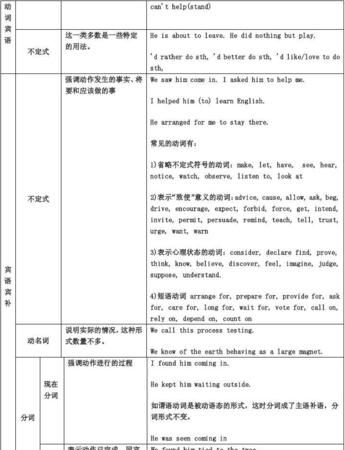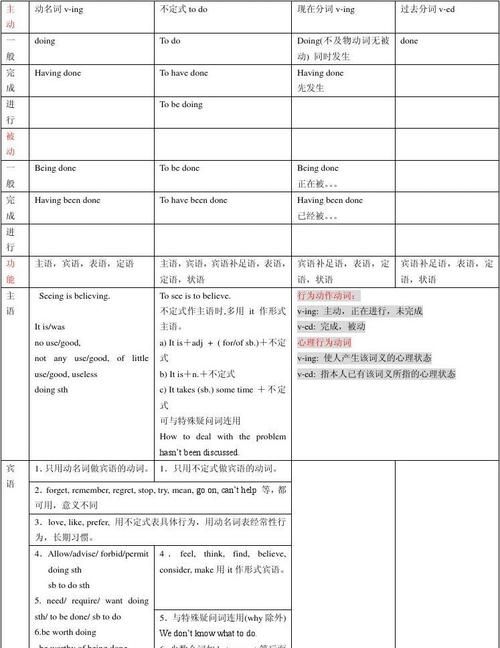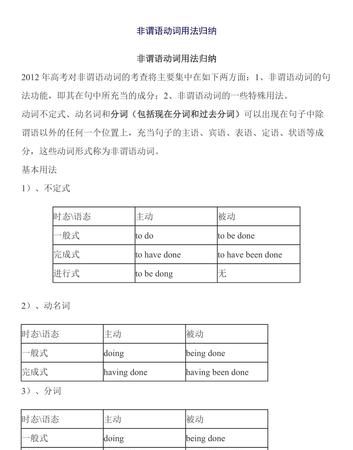本文目录
非谓语动词前加not
非谓语动词一共有三类:动名词、动词不定式、分词
看你的描述好像是有关于动词不定式的
和for sb 和of sb 有关的好像我记得有这么个句型:
it is (形容词)+for sb /of sb+ to do sth
这里it是形式主语,for sb是逻辑主语.
至于consider to做逻辑主语什么的这句话我不是很理解……lz能否解释地再清楚点……
另外You are consider to 这句语法有问题,consider是动词不能跟在be动词后面,我也不知道你想表达什么……是要翻译"你认为他做的怎样了"这句话吗?

非谓语动词的用法
导语: 非谓语动词在英语中很常见,关于非谓语动词的语法知识自然就要大家能够熟练掌握。下面是我为您收集整理的非谓语动词的用法,欢迎阅读!
一、非谓语动词的概念
动词的基本用法是作谓语。当句中已经有了谓语动词了,要选或要填的动词就只能用非谓语形式了。
非谓语形式有三种:1、动词不定式:to do 2、动词的ing : doing 3、动词的过去分词:done。其中不定式表示目的和将来;动词的ing表示主动和进行;过去分词表示被动和完成。
二、非谓语动词的时态和语态
一般式:不定式:主动to do ,被动to be done ; ing 形式:主动doing ,被动being done ;过去分词:被动done
完成式:不定式:主动to have done ,被动to have been done;ing 形式:主动having done,被动having been done
进行式: 不定式to be doing
三、非谓语动词的复合结构
不定式的复合结构:for / of sb. to do sth.
动词 ing 形式的复合结构:宾格或所有格+doing (-ing 形式作主语时,用的所有格+doing)
1. 不定式和动名词作主语的区别
(1)动名词作主语时,通常用以表示一件已知的事或经验,不定式短语通常用来表示一件未完成的事或目的。
Driving a car during the rush hour is tiring.在高峰时刻开车令人厌烦。(经验)
(2)不定式做主语,一般用it当形式主语,把作主语的不定式短语后置。
It took me only five minutes to finish the job.
2. 不定式、动名词和分词作表语的区别
(1)不定式作表语
① 不定式作表语一般表示具体动作,特别是表示将来的动作。
What I would suggest is to start work at once.我的建议是立刻开始干。
② 如果主语是不定式(表示条件),表语也要是不定式(表示结果)。
To see is to believe.百闻不如一见。
(2)动名词作表语:动名词作表语,表示抽象的一般性的`行为。
His hobby is collecting stamps.他的爱好是集邮。
(3)分词作表语
分词做表语有两种情况,一种是现在分词做表语,一种是过去分词做表语,这两者区别是考试中经常考到的地方。
puzzling令人费解的--puzzled感到费解的
satisfying令人满意的---satisfied感到满意的
The pupils will get confused if they are made to learn too much.如果要学生学得太多,他们会感到糊涂的。
The argument is very convincing.他的论点很令人信服。
3. 不定式和动名词作宾语的区别
(1)有少数动词只能用动名词作宾语
acknowledge,admit ,dislike, advocate,complete,appreciate ,avoid,enjoy,delay,escape,deny
例如:I appreciate having been given the opportunity to study abroad two years ago.
我很感激两年前给我出国学习的机会。
(2)有些动词后使用动名词和动词不定式作宾语的差别
① forget to do 忘记要去做某事(此事未做),forget doing忘记做过某事(此事已做过或已发生)
② stop to do 停止、中断(某件事),目的是去做另一件事。stop doing 停止正在或经常做的事
③ remember to do 记住去做某事(未做),remember doing记得做过某事(已做)
④ regret to do对要做的事遗憾,regret doing对做过的事遗憾、后悔
⑤ try to do努力、企图做某事,try doing试验、试一试某种办法
⑥ mean to do打算,有意要…,mean doing意味着
4. 不定式和分词作状语的区别
(1)现在分词与过去分词作状语的区别。
① 现在分词作状语时,现在分词的动作就是句子主语的动作,它们之间的关系是主动关系。
Not knowing what to do, he went to his parents for help.
② 过去分词作状语时,过去分词表示的动作是句子主语承受的动作,它们之间的关系是被动关系。
Given more attention, the trees could have grown better.
5. 非谓语动词常考的其它结构
(1)疑问词+不定式结构
疑问词who,what,which,when,where和how后加不定式可构成一种特殊的不定式短语。它在句中可以用作主语、宾语、表语和双重宾语。
When to start has not been decided.何时动身尚未决定。(主语)
I don't know what to do.我不知道该怎么办。(宾语)
The difficulty was how to cross the river.困难在于如何过河。(表语)
I can tell you where to get this book.我可以告诉你哪里可以买到此书。(双重宾语)
(2)不带to的不定式
① 在表示生理感觉的动词后的不定式不带to。
这类词有: feel observe overhear watch listen to perceive notice see look at hear
On seeing the young child fell into the lake,Eric sprang to his feet,and went on the rescue.
② 另一类是某些使役动词,如make, let,have等。
I would have you know that I am ill.我想让你知道我病了。
上述感觉动词与使意动词转换为被动结构时.其后的不定式一般需带to,
The boy was made to go to bed early.
③ 在do nothing/anything/everything but(except)结构中。
例如:Last night I did nothing but watch TV.
但是,如果谓语动词不是“do nothing,anything,everything”,那么but(except)所跟的不定式则仍须带to。
There was nothing for them to do but to remain silent.

在非谓语动词中动名词doing和现在分词doing有什么区别
for
prep. 介词时
(表示目的)为了, 因为, 至于, 对于, 适合于
例句:I will wait for you.
conj. 连词时
因为
例句:Einstein received worldwide praise for his scientific research.
to prep. 介词
to的用法
一:表示相对,针对
be strange to
二:表示对比,比较
1:以-ior结尾的形容词,后接介词to表示比较
senior,junior
2: 一些本身就含有比较或比拟意思的形容词
A is similar to B in many ways.
3:表示一些先后顺序的形容词
they returned to their hometown
4: to也偶尔出现在个别动词之后,与动词形成固定词组,表示比较
compare to sth.
5: to与及个别的名词构成比较之意,
Going to an under water concert is a great alternative to going to dinner.
三: 表示修饰关系
1: 表示回复,反应意思的词
answer to question
2: 表示建筑构件的词汇
the approach to science
3: 表示人物职位和官衔的词
assistant to manager
4: 表示权利和许可的词汇
Everyone has an equal right to
5: 表示栅栏或障碍的词汇
the barrier to progress
6: 表示与书籍,文本相关的词
introduction to passage
7: 表示恭喜或是祝贺
Let’s drink to Dick’s success in business
8: 另外还有一些名词符合这种用法,有的具有两者息息相关,缺一不可的含义
guide to action
四: to还具有依据,伴随,和着节奏的含义
sing to piano
(一):表示相关联,相连接
be related to
(二):表示反对和赞同
1:to引导的表示反对,抗拒,对抗意义的词组
Be opposed to
2: to引导的表示同意,赞同意义的词组
The employer consented to give him a salary raise
3: 表示投降,屈服,服从的含义
confess to
五: 表示趋势或倾向,
tend to
六: 表示对事情的坚持与执着
He still holds on to his original views
七: 表示约束,局限
limit to
八: 表示一种习惯或是一种适应性
get (be) to
九: 表示起因和原由
due to
十: 表示目的或结果
lead to
of
prep. 介词
...的, 由...制成的, 离, 关于, 对于
用法
1: 表示剥夺,除去
clarify the river of flowing rubbish
2: of接直接宾语
remind sb. of his duties
3: of接间接宾语
ask a question of sb
4: of表示人物的特性,籍贯,特性或出生等
He is of Irish descend
5: 固定词组
The room smells of stale cabbage.

of和for的区别
for和of引导的不定式结构的区别
不定式是一种非谓语动词,不能单独作谓语,因此没有语法上的主语。但由于不定式表示的是动作,在意义上可以有它的主体。我们称之为逻辑主语。
提起不定式逻辑主语,人们首先想到的会是“for+名词(宾格代词)+不定式”的复合结构。如:It is important for us to study English well.然而,有时不定式的逻辑主语须要用“of+名词(代词宾格)”才行。例如:It iskind of you to help me.而不能说:It is kind for you to help me.在选择介词“for”还是“of”时,人们往往总是凭感觉而定。有时受习惯影响,多选介词“for”。于是常出现这样的错误:It was careless for him to lose his way.It is cruel for you to do so.由于众多语法书对这种结构中使用“for”与“of”的区别介绍甚少,一些人对其概念认识尚不完全清楚,笔者认为有必要就这一问题作些探讨与介绍。
一、在句中的语法作用不同
a.不定式for结构在句中可以作主、宾、表、定、状、同位语:
1.It is easy for Tom to do this work.(主语)汤姆做此工作是容易的。
2.I'd like for him to come here.(宾语)我喜欢他来这里。
3.His idea is for us to travel in two different groups.(表语)他的想法是:我们分成两组旅行。
4.Have you heard about the plan for you to go abroad.(定语)你听到让你出国的计划吗?
5.The word is too difficult for him to pronounce well.(状语)这单词太难,他念不准。
6.In the most schools,it is the custom for the headmaster to declare the newterm start.在大部分学校,校长宣布新学期开始是一个习惯。
b.不定式of结构只能在句中作主语。
1.It was careless of him to leave his umbrella in the train.他把伞丢在火车上真是太粗心了。
2.It is awfully good of you to come to see me off at the station.谢谢你来车站送我。
二、逻辑主语的名词有所不同
a.不定式for结构中的名词可以是人,也可以是无生命的事物:
1.It is very important for us to study English well.我们学好英语是非常重要的。
2.It is essential for the classroom to have plenty of light.教室光线充足是必要的。
有时还可以是引导词“there”:
3.It is a pity for there to be any disagreement in the family.家庭不和实在是很遗憾。
4.In such case it is impossible for there to be an escape of air from the con-tainer.在这种情况下,不存在空气从容器溢出的可能性。
b.不定式of结构中的名词只能是人:
It is foolish of you to lend the money.你借钱给人真是太蠢了。
三、表语形容词的语义不同
表语形容词的语义不同是区别for结构和of结构的最重要标志。
a.在“It is(was)+adj.+for sb+to do sth”的句式中,作表语的形容词大多是表事物性质的静态形容词(stative adjective),如:essential,easy,difficult,important,neccessary,(im)possible,hard等等,这类形容词与for后面的名词(代词)关系不密切,无意义上的主表关系。例如:
It is neccessary for us to practise speaking English every day.
句中不定式逻辑主语“us”与表语形容词“neccessary”无主表关系,我们不能说:We are neccessary to practise speaking English every day.因为“人”(we)不能与表“事物性质的形容词”(neccessary)连用在一起。此句的重点,是强调“每天练习说英语”这件事。同样:It was very difficult for Tom to answer this question.不能说成:Tom was very difficult to answer this question.而可以说:For Tom to answer this question was very difficult.
b.在“It is(was)+ adj.+ of sb…”的句式中,作表语的形容词大多是表示人物特征的形容词。如:bold,absurd,brave,careless,careful,clever,considerate,cruel,foolish,good,honest,(un)kind noble,impudent,polite,right,rude,sweet,nutured,silly,stupid,selfish,thoughtful,ungrateful,wicked,unmanly,(un)wise,wrong等等。这些表示人物特征的形容词与of后的名词关系十分密切,有意义上的主表关系。如:
1.It is selfish of you to do so.
“you”与“selfish”关系密切。“you”既是不定式“to do so”的逻辑主语,又是形容词“selfish”的逻辑主语。此句重点强调的是“人”,(你这人太自私了)故可以说成:You are selfish to do so.又如:
2.It is kind of you(= You are kind)to send me a nice present.谢谢你送我这么好的礼物。
3.It was stupid of her(=she was stupid)to make such a mistake.出这样的错她真是太蠢了。
另外,在这个句式中,“it”可以根据情况改为“that”、“this”,如:
4.That is very kind of you.谢谢你。
5.This is very good of you to repair the TV set for me.谢谢你帮我修电视机。
较长的句子,还可以加逗号,在of sb与to do sth中间停顿一下:
6.That was smart of you,to hush up the affair before you heard about it.听到此事之前能保持缄默,你是很聪明的。
四、句子的语气有所不同
A.在较多的场合中,不定式for结构的句式语气带有情态意义。for sb todo sth.的复合结构,相当于一个有情态动词的主语从句。例如:
1.It is neccessary for us to get the preparations done.=(… that weshould get the preparations done.)我们有必要(应该)把准备工作做好。
2.It is hard for which one to be given the reward to.=(… which oneshould be given the reward to.)难就难在应该给哪个人授奖。
3.In the old society,it was rare for a poor man's son to go to college.(=… that a poor man's son could go to college.)旧社会,穷人的孩子能上大学是很少见的。
B.不定式of结构的句式,在语气上往往对前面表人物特征的表语形容词有着某种感叹意味。It is/was adj.of sb相当于How adj of sb it is/was.故在翻译时,多加上“太……”“真是……”“实在是……”等字眼,如前面提到的诸例句:
1.It was careless of him to leave his umbrella in the train.(= How carelessof him(it was)to leave his umbrella in the train.)他太粗心了,竟会把伞忘在车上。
2.That was stupid of you to make such a mistake.(= How stupid of you tomake such a mistake.)你竟然会犯这样的错误,真是太蠢了。
有时,为了加强感叹的程度还可以在表语形容词前加上修饰词:
3.That is really kind of you.
4.It is awfully good of him to come to see us off at the station.
五、由于某些形容词(如:good,right,foolish,wrong,silly…)在语义上具有两重性,既可以表人物的特征,又可以说明事物的性质,因此它们可以使用在for结构中,也可以使用在of结构中,但两种结构在意义上有所区别。试比较:
1.It is good for Xiao Wang to travel abroad.(= It's good to travel abroad for-Xiao Wang)中心意思是说“旅行是件好事”,重点在“to travel abroad”不定式所表示的动作。“for Xiao Wang”只表示一种范围。(对于小王来说)
2.It is good of Xiao Wang to lend me the money.
“of”表示一种所属关系,“good”是“Xiao Wang”的所属特征。中心意思是说“小王心眼真好”,重点在“Xiao Wang”这个人上。又如:
3.It is foolish of you to buy that book.(= You are foolish to buy that book.)你这人真傻,竟买了那本书。(强调“你傻”)
4.It is foolish for you to buy that book.(=For you to buy that book is fool-ish(= It is foolish to buy that book for you.)你买那本书是愚蠢的。(强调“买那本书”这件事很傻)
参考资料:http://218.24.233.167:8000/Resource/GZ/GZYY/YYXKLW/JXFF/XYYGLSC/421f0065zw_0137.htm to 表示目的 方向
for 译 为.... 后接名词
of 一般译成 ....的 与其后的名词 相当与形容词
例One of the legs of the table was broken.桌子的一条腿断了

以上就是关于非谓语动词of和for的用法,非谓语动词前加not的全部内容,以及非谓语动词of和for的用法 的相关内容,希望能够帮到您。
